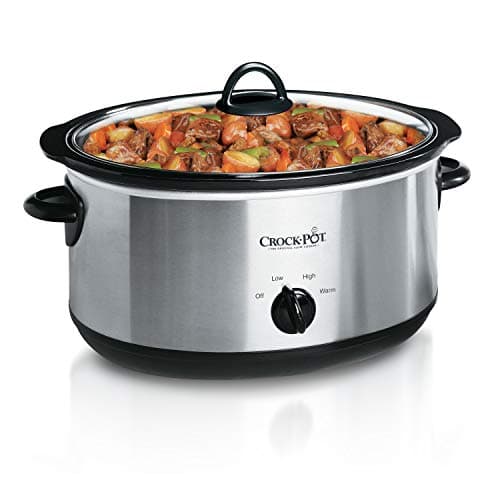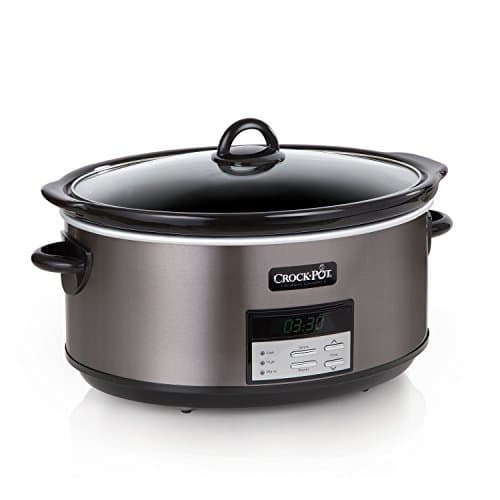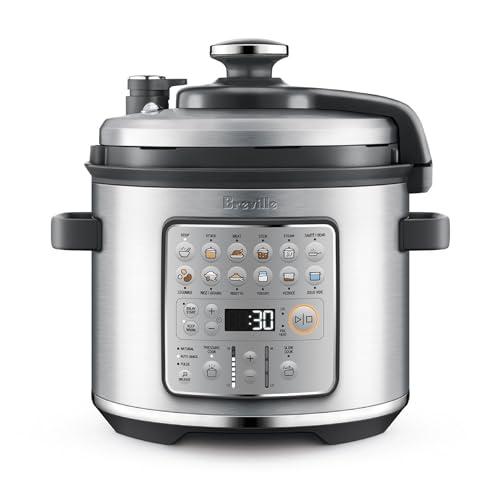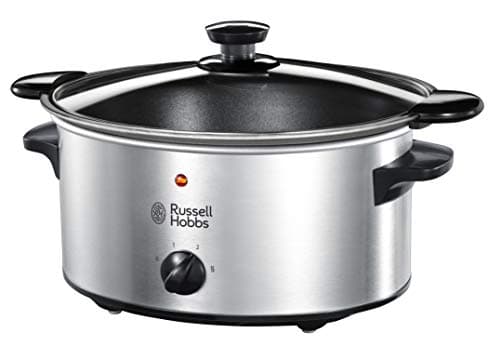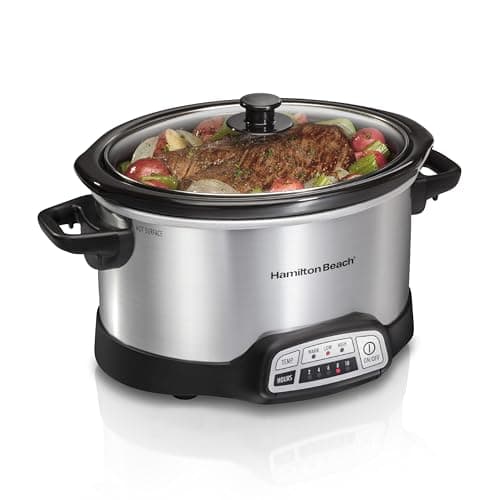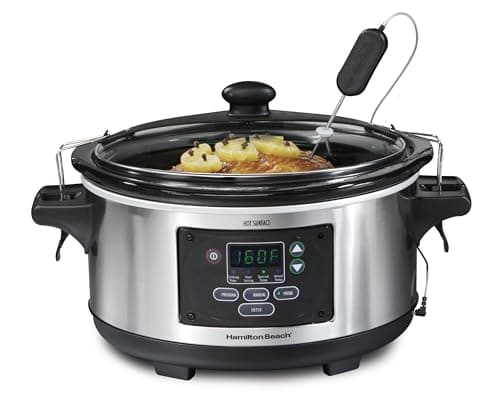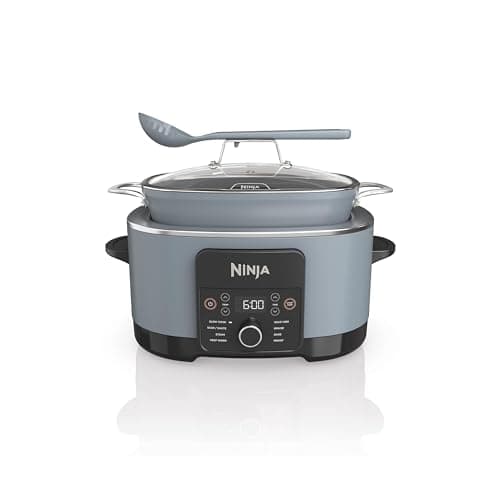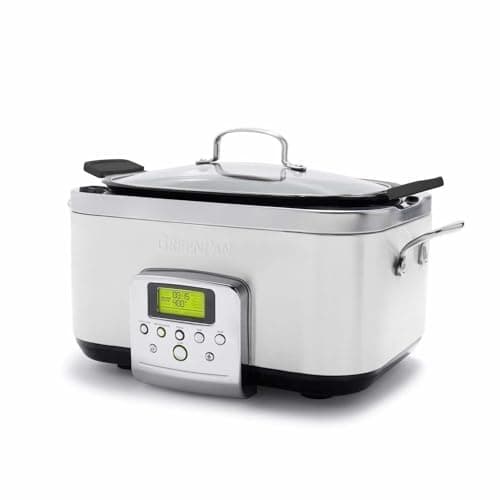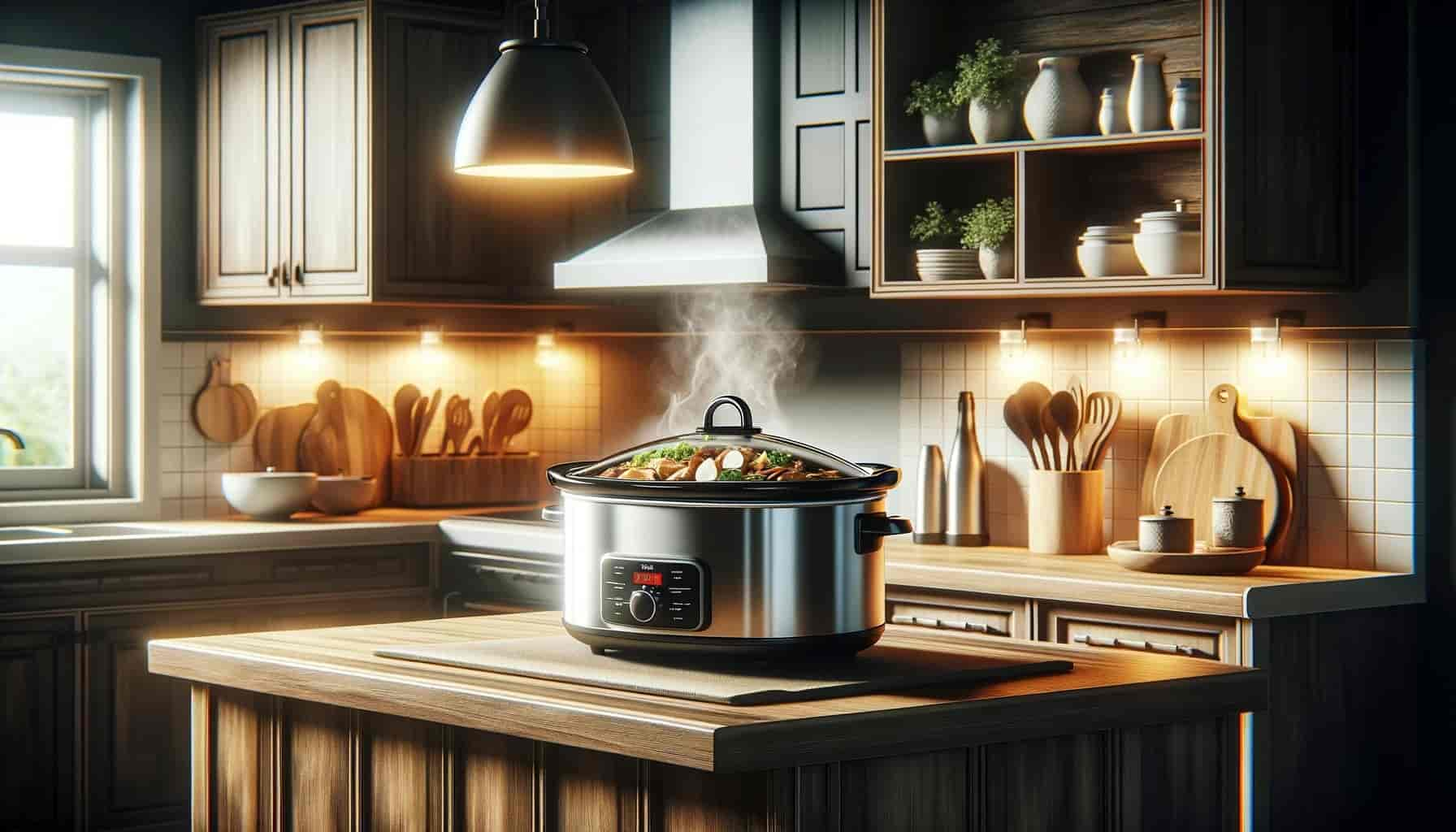
10 Best Greenpan Slow Cookers of 2024
At Greatest.Guide, our team of experienced experts and cutting-edge AI technology work together to curate a list of the top 10 best greenpan slow cookers available on the market today. By relying on our expert analysis, you save valuable time and money. Join the growing number of savvy shoppers who trust Greatest.Guide daily for reliable product recommendations.
Updated May 20, 2024
Greatest.Guide receives a small commission if you shop through our links at no extra cost to you.
Affiliate Disclosure
Sort..
Disclaimer: While we strive for accuracy, we cannot guarantee that all product features listed are complete or error-free. Please confirm the details with the retailer before making a purchase.
Similar
How We Rank
Our rankings at Greatest.Guide are the result of advanced analysis, authentic user feedback, and expert evaluations. This blend of technology and human insight ensures our top product selections are reliable and relevant.
Our #1 Pick
Crock Pot Connoisseur: A Comprehensive Guide to Slow Cooking
Introduction to Slow Cooking
Welcome to the heartwarming world of slow cooking, a culinary technique that transforms simple ingredients into mouthwatering meals with minimal effort. At its essence, slow cooking is a method where food is cooked at low temperatures over a long period of time. This gentle process allows flavors to meld and deepen, creating dishes that are rich and complex, with tender textures that simply can't be rushed.
Imagine coming home to the aroma of a stew that's been simmering to perfection, or a roast so tender it falls off the bone – that's the magic of a slow cooker. It's like having a personal chef patiently crafting your meal while you go about your day. Slow cooking is especially perfect for busy individuals who yearn for homemade meals but lack the time to stand over a stove. Thanks to its set-it-and-forget-it nature, you'll have more time at your disposal without sacrificing the quality of your meals.
Slow cooking isn't just about convenience; it's a healthier way to cook too. The low temperatures mean less chance of burning your food, preserving nutrients and flavors that high heat can destroy. Plus, the closed environment retains moisture, so you can use leaner cuts of meat without worrying about them drying out. Slow cookers are your ticket to wholesome, flavorful meals that prioritize both your health and your taste buds.
Imagine coming home to the aroma of a stew that's been simmering to perfection, or a roast so tender it falls off the bone – that's the magic of a slow cooker. It's like having a personal chef patiently crafting your meal while you go about your day. Slow cooking is especially perfect for busy individuals who yearn for homemade meals but lack the time to stand over a stove. Thanks to its set-it-and-forget-it nature, you'll have more time at your disposal without sacrificing the quality of your meals.
Slow cooking isn't just about convenience; it's a healthier way to cook too. The low temperatures mean less chance of burning your food, preserving nutrients and flavors that high heat can destroy. Plus, the closed environment retains moisture, so you can use leaner cuts of meat without worrying about them drying out. Slow cookers are your ticket to wholesome, flavorful meals that prioritize both your health and your taste buds.
Understanding Slow Cooker Sizes
When it comes to the Size & Capacity of slow cookers, think of the story of Goldilocks and the Three Bears—you want one that's just right. But what does "just right" mean when it comes to slow cooking? It means considering how many mouths you have to feed. A small 1 to 2-quart slow cooker is perfect for dips or meals for one. A family of four will be well-served by a 4 to 6-quart model, while a 7-quart or larger slow cooker can handle large cuts of meat or potluck-sized portions with ease.
Think about your kitchen space as well. A larger slow cooker will need more counter space and storage. But don't be tempted to overfill a smaller model to compensate—most manufacturers recommend filling them only two-thirds to three-quarters full to ensure even cooking and prevent spillage.
If you're a meal-prepper or love leftovers, you might lean towards a bigger size for that extra chili to tuck away in the freezer. On the other hand, if you're all about fresh and immediate meals, a smaller slow cooker could be the key to reducing food waste.
And remember, the shape of your slow cooker matters too. Oval slow cookers are great for large cuts of meat or whole chickens, while round ones can be more practical for soups, stews, and even baking bread. The size and shape you choose will directly impact the versatility and type of dishes you can prepare. So, consider your cooking habits and favorite recipes when deciding on the size and capacity that will best enhance your culinary adventures.
Think about your kitchen space as well. A larger slow cooker will need more counter space and storage. But don't be tempted to overfill a smaller model to compensate—most manufacturers recommend filling them only two-thirds to three-quarters full to ensure even cooking and prevent spillage.
If you're a meal-prepper or love leftovers, you might lean towards a bigger size for that extra chili to tuck away in the freezer. On the other hand, if you're all about fresh and immediate meals, a smaller slow cooker could be the key to reducing food waste.
And remember, the shape of your slow cooker matters too. Oval slow cookers are great for large cuts of meat or whole chickens, while round ones can be more practical for soups, stews, and even baking bread. The size and shape you choose will directly impact the versatility and type of dishes you can prepare. So, consider your cooking habits and favorite recipes when deciding on the size and capacity that will best enhance your culinary adventures.
Types of Slow Cookers
Embark on a culinary journey with the vast array of slow cooker varieties that cater to every chef's needs. Traditional slow cookers offer a simplistic yet effective approach - a sturdy ceramic pot ensconced in a metal casing with a lid, it's a set-and-forget kitchen ally for countless recipes.
For the modern home cook, programmable slow cookers are like having a sous chef in your kitchen. With digital timers and various settings, they give you the freedom to tailor your cooking process to the minute, ensuring a hot meal ready precisely when you want it.
Let's not forget the multi-cookers – these versatile titans combine slow cooking with pressure cooking, steaming, and even sautéing, offering a one-pot solution for virtually any dish. Busy bees will appreciate the ability to whip up a risotto or stew with the same device.
Looking for something portable? Travel-friendly slow cookers with locking lids offer peace of mind for potlucks or camping trips, ensuring your culinary creations arrive intact without a spill in sight.
Lastly, the Double Slow Cookers are perfect for multitaskers and entertainers, allowing you to cook two different dishes simultaneously – think savory pulled pork on one side and a decadent chocolate lava cake on the other.
It's clear that no matter your lifestyle or cooking preferences, there's a slow cooker out there to match. From the simplest models to high-tech kitchen wizards, slow cookers have evolved to become indispensable tools for anyone who loves to cook and eat well.
For the modern home cook, programmable slow cookers are like having a sous chef in your kitchen. With digital timers and various settings, they give you the freedom to tailor your cooking process to the minute, ensuring a hot meal ready precisely when you want it.
Let's not forget the multi-cookers – these versatile titans combine slow cooking with pressure cooking, steaming, and even sautéing, offering a one-pot solution for virtually any dish. Busy bees will appreciate the ability to whip up a risotto or stew with the same device.
Looking for something portable? Travel-friendly slow cookers with locking lids offer peace of mind for potlucks or camping trips, ensuring your culinary creations arrive intact without a spill in sight.
Lastly, the Double Slow Cookers are perfect for multitaskers and entertainers, allowing you to cook two different dishes simultaneously – think savory pulled pork on one side and a decadent chocolate lava cake on the other.
It's clear that no matter your lifestyle or cooking preferences, there's a slow cooker out there to match. From the simplest models to high-tech kitchen wizards, slow cookers have evolved to become indispensable tools for anyone who loves to cook and eat well.
Key Features to Consider
When it comes to the important features of a slow cooker, there's a smorgasbord of elements to feast your eyes on that can make your culinary slow cooking journey both delectable and convenient. Let's take a leisurely stroll through these features to ensure you find your perfect kitchen companion.
First off, take a gander at the inner pot material. Typically, you'll find ceramic or porcelain, which are champions at evenly distributing heat but they tend to be heavier. Alternatively, a non-stick metal pot can make the clean-up a breeze, just be mindful of its durability and scratch-resistance.
A lid that seals the deal – it's not just about trapping in the flavors, but also about keeping an eye on your food as it simmers to perfection. A glass lid can be your window to wonder, allowing you to monitor progress without lifting the lid and letting out precious heat.
Don't underestimate the power of a good timer. It's more than just a countdown; it's your ticket to timing flexibility. With programmable settings, you can set your slow cooker to start while you're away and come home to a meal ready to serve.
Let's talk about heat settings. The holy trinity of Low, High, and Warm settings are essential. Low and High dictate the speed of cooking, while the Warm setting makes sure your dish stays at an appetizing temperature without overdoing it.
The significance of handles and knobs shouldn't be brushed off; cool-touch technology ensures that you won't need a potholder for every adjustment or when transporting your culinary creation from kitchen to table.
And for those who dread the aftermath of a feast, a removable pot is worth its weight in gold. It not only makes serving straightforward but also ensures that cleaning up is as painless as possible, especially if it's dishwasher-safe.
Lastly, a wink at integrated technologies might catch your fancy. Some models come equipped with smart features like Wi-Fi connectivity, allowing you to control and monitor your slow cooking from afar. Now, isn't that a modern twist to traditional cooking?
Remember, these features are like ingredients, and your preferences will determine the recipe for your ideal slow cooker. So choose those that will best enhance your slow cooking saga!
First off, take a gander at the inner pot material. Typically, you'll find ceramic or porcelain, which are champions at evenly distributing heat but they tend to be heavier. Alternatively, a non-stick metal pot can make the clean-up a breeze, just be mindful of its durability and scratch-resistance.
A lid that seals the deal – it's not just about trapping in the flavors, but also about keeping an eye on your food as it simmers to perfection. A glass lid can be your window to wonder, allowing you to monitor progress without lifting the lid and letting out precious heat.
Don't underestimate the power of a good timer. It's more than just a countdown; it's your ticket to timing flexibility. With programmable settings, you can set your slow cooker to start while you're away and come home to a meal ready to serve.
Let's talk about heat settings. The holy trinity of Low, High, and Warm settings are essential. Low and High dictate the speed of cooking, while the Warm setting makes sure your dish stays at an appetizing temperature without overdoing it.
The significance of handles and knobs shouldn't be brushed off; cool-touch technology ensures that you won't need a potholder for every adjustment or when transporting your culinary creation from kitchen to table.
And for those who dread the aftermath of a feast, a removable pot is worth its weight in gold. It not only makes serving straightforward but also ensures that cleaning up is as painless as possible, especially if it's dishwasher-safe.
Lastly, a wink at integrated technologies might catch your fancy. Some models come equipped with smart features like Wi-Fi connectivity, allowing you to control and monitor your slow cooking from afar. Now, isn't that a modern twist to traditional cooking?
Remember, these features are like ingredients, and your preferences will determine the recipe for your ideal slow cooker. So choose those that will best enhance your slow cooking saga!
Programmable vs. Manual Slow Cookers
When it comes to slow cookers, control settings are your command center for culinary magic. Whether you're a set-it-and-forget-it chef or someone who likes to tweak every aspect of cooking, these settings are crucial to how your dish turns out.
Programmable slow cookers offer a digital interface where you can set specific cooking times and temperatures. Some models even allow you to delay the start of cooking, which means you can load up your pot in the morning and come home to a freshly cooked meal. After the set time elapses, these smart devices often switch to a warm setting automatically, keeping your food at an ideal temperature without overcooking it.
On the flip side, manual slow cookers often come with a simpler approach: a dial or switch that lets you choose between low, high, and sometimes keep warm settings. While they lack the ability to program specific times, they're perfect for those who prefer the hands-on approach or are on a budget. Plus, there's a kind of culinary romance in tweaking the settings based on smell, sight, and taste as your dish progresses.
No matter what your preference is, consider how often you'll be around to monitor your meal. If your lifestyle demands flexibility, a programmable slow cooker might be your best bet. On the other hand, if you enjoy being more involved in the cooking process, a manual slow cooker can be a trusty companion in crafting your comfort foods. Remember, the right control settings will ensure that your slow-cooked meals are not only delicious but also tailored to your daily routine and cooking style.
Programmable slow cookers offer a digital interface where you can set specific cooking times and temperatures. Some models even allow you to delay the start of cooking, which means you can load up your pot in the morning and come home to a freshly cooked meal. After the set time elapses, these smart devices often switch to a warm setting automatically, keeping your food at an ideal temperature without overcooking it.
On the flip side, manual slow cookers often come with a simpler approach: a dial or switch that lets you choose between low, high, and sometimes keep warm settings. While they lack the ability to program specific times, they're perfect for those who prefer the hands-on approach or are on a budget. Plus, there's a kind of culinary romance in tweaking the settings based on smell, sight, and taste as your dish progresses.
No matter what your preference is, consider how often you'll be around to monitor your meal. If your lifestyle demands flexibility, a programmable slow cooker might be your best bet. On the other hand, if you enjoy being more involved in the cooking process, a manual slow cooker can be a trusty companion in crafting your comfort foods. Remember, the right control settings will ensure that your slow-cooked meals are not only delicious but also tailored to your daily routine and cooking style.
Energy Efficiency and Safety
When it comes to slow cookers, the mantra 'set it and forget it' is a testament to their energy efficiency and safety. These culinary companions are designed to simmer away for hours, using less electricity than a traditional oven, making them a cost-effective addition to your kitchen appliances. Low energy consumption is one of the alluring charms of slow cooking, ideal for eco-conscious foodies looking to reduce their carbon footprint without sacrificing the pleasures of a home-cooked meal.
Safety is a paramount concern in any kitchen, and slow cookers score high in this arena. Many models come equipped with cool-touch handles and automatic shut-off features, minimizing the risk of burns or accidents. Overheating protection is another layer of defense, ensuring that your culinary creation cooks at the right temperature without the hazard of getting too hot. Look for a slow cooker with a locking lid to seal in the heat and prevent spills—especially handy if you're transporting your dish to a potluck or gathering.
Most slow cookers have a ceramic or porcelain insert, which coupled with the insulated outer shell, provides an even cooking environment that gently circulates heat. This not only contributes to energy efficiency but also prevents scorching, sticking, or uneven cooking—your stews and roasts will be tender, not toasted! To enhance safety, always ensure there's enough liquid in the pot to prevent drying out, and never put a cold ceramic insert into a pre-heated base; the sudden change in temperature can cause it to crack.
Lastly, smart technology integration in modern slow cookers is redefining kitchen safety and efficiency. With features like wi-fi connectivity and programmable timers, you can control and monitor your slow cooker remotely, adjusting cooking times and temperatures to perfection. This means even if you're stuck at work or running late, your slow cooker adapts, ensuring your food is deliciously ready and safe to eat whenever you are. Embrace the ease and peace of mind these features bring, knowing your slow-cooked meals are not just mouth-watering but also made with the utmost care for energy conservation and safety.
Safety is a paramount concern in any kitchen, and slow cookers score high in this arena. Many models come equipped with cool-touch handles and automatic shut-off features, minimizing the risk of burns or accidents. Overheating protection is another layer of defense, ensuring that your culinary creation cooks at the right temperature without the hazard of getting too hot. Look for a slow cooker with a locking lid to seal in the heat and prevent spills—especially handy if you're transporting your dish to a potluck or gathering.
Most slow cookers have a ceramic or porcelain insert, which coupled with the insulated outer shell, provides an even cooking environment that gently circulates heat. This not only contributes to energy efficiency but also prevents scorching, sticking, or uneven cooking—your stews and roasts will be tender, not toasted! To enhance safety, always ensure there's enough liquid in the pot to prevent drying out, and never put a cold ceramic insert into a pre-heated base; the sudden change in temperature can cause it to crack.
Lastly, smart technology integration in modern slow cookers is redefining kitchen safety and efficiency. With features like wi-fi connectivity and programmable timers, you can control and monitor your slow cooker remotely, adjusting cooking times and temperatures to perfection. This means even if you're stuck at work or running late, your slow cooker adapts, ensuring your food is deliciously ready and safe to eat whenever you are. Embrace the ease and peace of mind these features bring, knowing your slow-cooked meals are not just mouth-watering but also made with the utmost care for energy conservation and safety.
Extra Functions: Beyond Slow Cooking
When you're in the market for a slow cooker, think beyond the traditional "set-it-and-forget-it" stew and soup applications. Modern slow cookers come with a variety of versatile functions that can transform your kitchen routine. Many models now offer sautéing, steaming, and even roasting capabilities. With these extra features, you can brown meats before slow cooking to lock in flavor or steam your veggies to perfection, all with the same appliance.
The multifunctionality continues with options such as rice cooking, yogurt making, and baking, which are becoming increasingly popular in newer slow cookers. Imagine the convenience of preparing creamy, homemade yogurt overnight or baking a moist cake without turning on your oven. These multicookers are perfect for small kitchens or for those looking to minimize clutter by replacing several appliances with one.
Additionally, some slow cookers come with programmable features that allow for a customized cooking experience. This means you can tailor the cooking process to the recipe you're using, whether it's slow cooking a chili for 8 hours or quickly pressure cooking beans in under an hour. And don't forget about the keep-warm function, which ensures your meal is hot and ready to serve whenever you are, adding convenience to your mealtime.
With these advanced functions, your slow cooker can become the most versatile tool in your kitchen. As you shop, keep an eye out for these additional capabilities to make sure you're getting a machine that can keep up with your culinary creativity and your busy lifestyle.
The multifunctionality continues with options such as rice cooking, yogurt making, and baking, which are becoming increasingly popular in newer slow cookers. Imagine the convenience of preparing creamy, homemade yogurt overnight or baking a moist cake without turning on your oven. These multicookers are perfect for small kitchens or for those looking to minimize clutter by replacing several appliances with one.
Additionally, some slow cookers come with programmable features that allow for a customized cooking experience. This means you can tailor the cooking process to the recipe you're using, whether it's slow cooking a chili for 8 hours or quickly pressure cooking beans in under an hour. And don't forget about the keep-warm function, which ensures your meal is hot and ready to serve whenever you are, adding convenience to your mealtime.
With these advanced functions, your slow cooker can become the most versatile tool in your kitchen. As you shop, keep an eye out for these additional capabilities to make sure you're getting a machine that can keep up with your culinary creativity and your busy lifestyle.
Ease of Cleaning
Imagine enjoying a sumptuous slow-cooked meal without dreading the cleanup that follows. A slow cooker that promises ease of cleaning can be a game-changer in your kitchen routine. Look for models with a removable cooking pot that can be lifted out for a quick wash. Non-stick surfaces or ceramic inserts are not just for cooking evenly but make scrubbing a thing of the past.
Dishwasher safety is another hallmark of a low-maintenance slow cooker. If you want to skip the sink altogether, opt for a model whose lid and pot are both dishwasher-safe, ensuring you spend less time cleaning and more time enjoying your culinary creations.
When it comes to maintenance, simplicity wins. Slow cookers with fewer crevices and a seamless design prevent food from getting trapped, making them much easier to clean. A model with a detachable power cord also enhances the cleaning process, as it removes the awkwardness of maneuvering around wires.
Remember, regular cleaning extends the life of your slow cooker and ensures that the flavors of your dishes remain true. Most slow cookers come with care instructions tailored to the model, so a quick glance at the manual will keep your device in tip-top shape. Happy slow cooking and even happier cleaning!
Dishwasher safety is another hallmark of a low-maintenance slow cooker. If you want to skip the sink altogether, opt for a model whose lid and pot are both dishwasher-safe, ensuring you spend less time cleaning and more time enjoying your culinary creations.
When it comes to maintenance, simplicity wins. Slow cookers with fewer crevices and a seamless design prevent food from getting trapped, making them much easier to clean. A model with a detachable power cord also enhances the cleaning process, as it removes the awkwardness of maneuvering around wires.
Remember, regular cleaning extends the life of your slow cooker and ensures that the flavors of your dishes remain true. Most slow cookers come with care instructions tailored to the model, so a quick glance at the manual will keep your device in tip-top shape. Happy slow cooking and even happier cleaning!
Accessories and Add-ons
Unlock the full potential of your slow cooking experience with a dash of thoughtfully chosen accessories! Depending on how you plan to use your slow cooker, certain add-ons can elevate your culinary game. Consider a digital meat thermometer to ensure your roasts achieve perfect doneness without having to lift the lid and interrupt cooking.
For those who love to serve directly from the cooker at potlucks or family gatherings, a travel bag is a game-changer. It keeps your food warm and prevents spills during transport. If you're into making stews or soups, a ladle with a heat-resistant handle is a must-have for serving.
When it comes to leftovers or meal prep, airtight storage containers that are both freezer and microwave safe can save you time and keep your meals fresh. And let’s not forget about the slow cooker liners – they might not be the most glamorous accessory, but these nifty bags can significantly reduce your cleaning time.
For those who enjoy a touch of tech, consider investing in a Wi-Fi-enabled plug. This nifty gadget allows you to turn your slow cooker on or off when you're away from home, ensuring you have full control over your meal times.
Lastly, a recipe book dedicated to slow cooking can inspire you with new dishes and ensure you're making the most of your appliance. Whether it's creating overnight oatmeal for breakfast or a decadent chocolate lava cake for dessert, the right accessory can make all the difference in your slow cooking journey.
For those who love to serve directly from the cooker at potlucks or family gatherings, a travel bag is a game-changer. It keeps your food warm and prevents spills during transport. If you're into making stews or soups, a ladle with a heat-resistant handle is a must-have for serving.
When it comes to leftovers or meal prep, airtight storage containers that are both freezer and microwave safe can save you time and keep your meals fresh. And let’s not forget about the slow cooker liners – they might not be the most glamorous accessory, but these nifty bags can significantly reduce your cleaning time.
For those who enjoy a touch of tech, consider investing in a Wi-Fi-enabled plug. This nifty gadget allows you to turn your slow cooker on or off when you're away from home, ensuring you have full control over your meal times.
Lastly, a recipe book dedicated to slow cooking can inspire you with new dishes and ensure you're making the most of your appliance. Whether it's creating overnight oatmeal for breakfast or a decadent chocolate lava cake for dessert, the right accessory can make all the difference in your slow cooking journey.
Price Range and Brands
When exploring the world of slow cookers, you'll quickly notice there's a spectrum of prices that cater to both frugal foodies and gourmet gurus. On the budget-friendly side, you can find basic models that don't skimp on quality but may offer fewer features. Brands like Crock-Pot and Hamilton Beach lead the pack, offering sturdy, no-frills options that are perfect for slow cooking newcomers or those who prefer simplicity.
Stepping up in price, you can indulge in mid-range models that introduce more sophisticated controls and added functionality. KitchenAid and Cuisinart are notable brands in this category, striking an appealing balance between cost and convenience with features like programmable timers and multi-cooking capabilities.
For the true slow cooking aficionado, premium brands like All-Clad and Breville offer top-tier appliances. These models come with a heftier price tag but justify the investment with superior build quality, advanced technology, and impressive durability. They're often the choice of serious home chefs looking to expand their culinary repertoire.
Regardless of budget, it's key to consider the brand's reputation for warranty and customer service. A higher upfront cost might mean more savings in the long run if the brand offers a strong warranty and excellent support, ensuring that your slow cooker remains a reliable kitchen companion for years to come.
Stepping up in price, you can indulge in mid-range models that introduce more sophisticated controls and added functionality. KitchenAid and Cuisinart are notable brands in this category, striking an appealing balance between cost and convenience with features like programmable timers and multi-cooking capabilities.
For the true slow cooking aficionado, premium brands like All-Clad and Breville offer top-tier appliances. These models come with a heftier price tag but justify the investment with superior build quality, advanced technology, and impressive durability. They're often the choice of serious home chefs looking to expand their culinary repertoire.
Regardless of budget, it's key to consider the brand's reputation for warranty and customer service. A higher upfront cost might mean more savings in the long run if the brand offers a strong warranty and excellent support, ensuring that your slow cooker remains a reliable kitchen companion for years to come.
Real User Reviews and Recommendations
When it comes to slow cookers, the proof is truly in the pudding—or in this case, the pot roast! User experiences are the golden nuggets of wisdom that can guide you to your perfect kitchen companion. As you peruse through reviews, you'll notice that slow cooker aficionados often praise the set-and-forget convenience, sharing stories of returning home to mouthwatering aromas and ready-to-serve dinners.
Dive into the world of user reviews, and you'll uncover a treasure trove of personal anecdotes. One might read about a busy parent who managed to attend all their kids' soccer games thanks to their trusty slow cooker taking care of dinner. Another could be from a health-conscious foodie who found joy in the easily controlled cooking process that preserves nutrients and flavor. These real-life experiences often highlight the practical benefits of specific features, such as programmable timers or multiple heat settings, that aren't apparent from a spec sheet alone.
Don't underestimate the power of a star rating or a well-worded testimonial. Look for patterns in feedback—multiple mentions of a slow cooker's durable construction or its effortless cleanup can be the deciding factor in your choice. But also be vigilant for any consistent critiques; perhaps users frequently comment on a particular model's lid not sealing properly, which could be a red flag.
Remember, user experiences do more than validate the quality of a slow cooker; they provide a glimpse into the lifestyle enhancements that come with the right choice. Whether it's stories of adventurous home chefs trying out new recipes or the relief expressed by those who've finally found a way to juggle work and nutritious home-cooked meals, these narratives are the compass that can lead you to a purchase that truly fits your needs.
Dive into the world of user reviews, and you'll uncover a treasure trove of personal anecdotes. One might read about a busy parent who managed to attend all their kids' soccer games thanks to their trusty slow cooker taking care of dinner. Another could be from a health-conscious foodie who found joy in the easily controlled cooking process that preserves nutrients and flavor. These real-life experiences often highlight the practical benefits of specific features, such as programmable timers or multiple heat settings, that aren't apparent from a spec sheet alone.
Don't underestimate the power of a star rating or a well-worded testimonial. Look for patterns in feedback—multiple mentions of a slow cooker's durable construction or its effortless cleanup can be the deciding factor in your choice. But also be vigilant for any consistent critiques; perhaps users frequently comment on a particular model's lid not sealing properly, which could be a red flag.
Remember, user experiences do more than validate the quality of a slow cooker; they provide a glimpse into the lifestyle enhancements that come with the right choice. Whether it's stories of adventurous home chefs trying out new recipes or the relief expressed by those who've finally found a way to juggle work and nutritious home-cooked meals, these narratives are the compass that can lead you to a purchase that truly fits your needs.
Conclusion: Making Your Selection
With the savory scent of a hearty stew simmering in your kitchen, you'll know that choosing the right slow cooker was worth every moment of consideration. As we wrap up our guide, remember that your final decision should marry the practicality of features with the personalized touch of your cooking style. Harmonizing size with need is essential; a compact model may be perfect for dips and fondues, while larger gatherings call for more generous capacities.
Consider the long game when pondering efficiency and safety. A slow cooker that boasts energy-efficient credentials and enhanced safety features not only serves up delicious meals but also peace of mind. Plus, don't forget the allure of versatile functions; a multifunctional machine can be a chef's best friend, expanding your culinary repertoire with minimal effort.
The ease of cleaning cannot be overstated—after all, no one wants to end their dining experience scraping away at a stubborn pot. And just like a cherry on top, additional accessories can sweeten the deal, providing that extra convenience or creativity in presentation.
Your budget will speak volumes, but remember that investing in a reputable brand can often save you from future frustration. User experiences and reviews are invaluable; they're the collective wisdom of the cooking community that can help steer you towards satisfaction or away from regret.
In the end, whatever your choice may be, embrace the journey towards rich, flavorful meals that only a slow cooker can provide. Let your kitchen be a place of gastronomic adventure, simmering with the joy of cooking and the warmth of sharing. Bon appétit!
Consider the long game when pondering efficiency and safety. A slow cooker that boasts energy-efficient credentials and enhanced safety features not only serves up delicious meals but also peace of mind. Plus, don't forget the allure of versatile functions; a multifunctional machine can be a chef's best friend, expanding your culinary repertoire with minimal effort.
The ease of cleaning cannot be overstated—after all, no one wants to end their dining experience scraping away at a stubborn pot. And just like a cherry on top, additional accessories can sweeten the deal, providing that extra convenience or creativity in presentation.
Your budget will speak volumes, but remember that investing in a reputable brand can often save you from future frustration. User experiences and reviews are invaluable; they're the collective wisdom of the cooking community that can help steer you towards satisfaction or away from regret.
In the end, whatever your choice may be, embrace the journey towards rich, flavorful meals that only a slow cooker can provide. Let your kitchen be a place of gastronomic adventure, simmering with the joy of cooking and the warmth of sharing. Bon appétit!
Our #1 Pick
